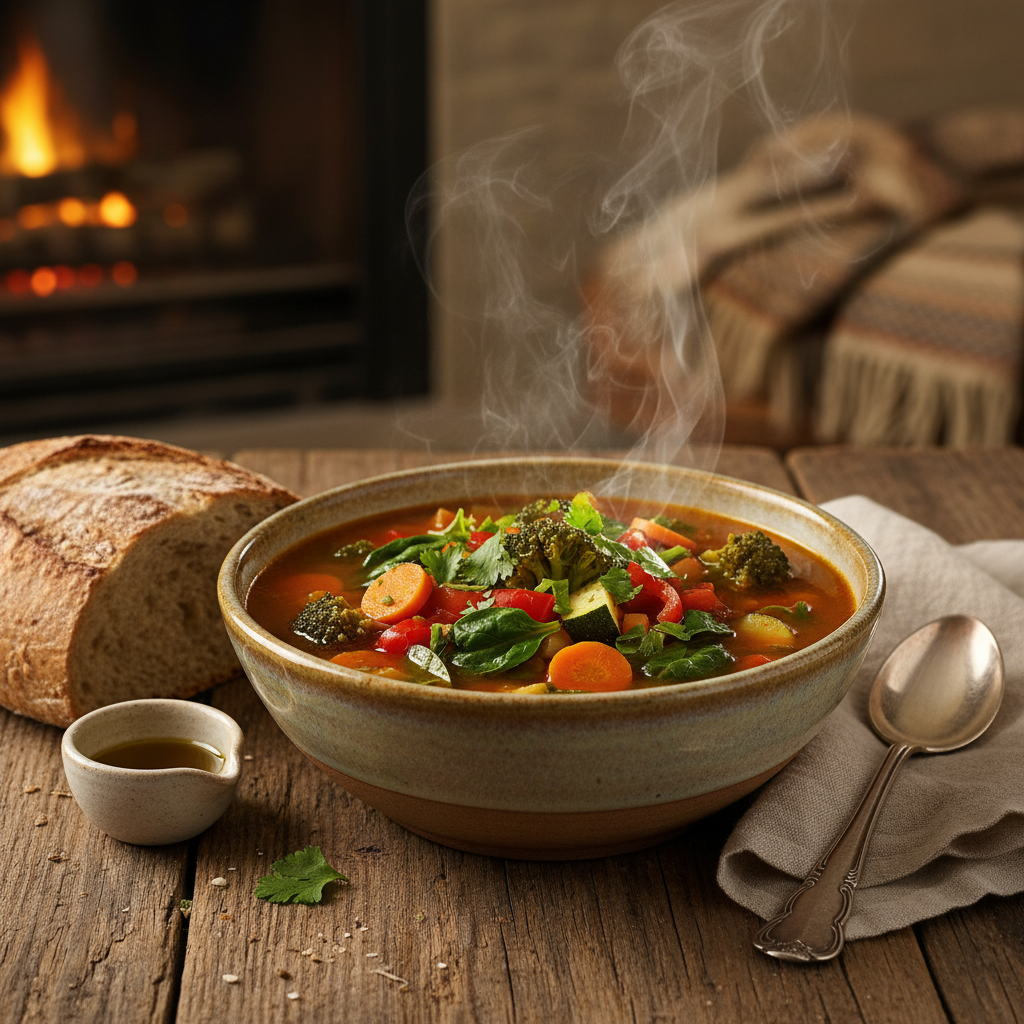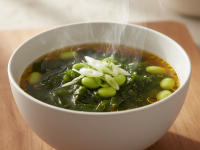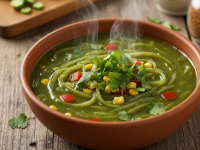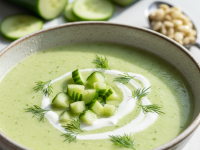Hey there, fellow food lovers and wellness seekers! Have you ever felt that nagging feeling in your gut – literally? Maybe you’re familiar with bloating, sluggishness, or just that general “unsettled” sensation. Trust me, I’ve been there. For years, I struggled to find meals that truly nourished my body without leaving me feeling heavy or unsatisfied. I wanted something light, delicious, and genuinely beneficial for my digestive system. And then, I discovered the magic of a really good, low-calorie, gut-friendly soup.
It sounds simple, right? Just soup. But this isn’t just any soup. This is *the* soup that genuinely changed how I felt about my gut health. It’s packed with nutrients, easy on the digestive system, incredibly satisfying, and yes, wonderfully low in calories. It’s become my secret weapon against digestive woes and a staple in my healthy eating routine. Today, I want to share my personal journey and, of course, the recipe that has made such a difference for me. So, pull up a chair, grab a mug, and let’s dive into how you can sip your way to a happier gut!
Why Soup? The Unsung Hero of Gut Health
Before we get to the recipe, let’s talk about why soup, in particular, is such a fantastic choice for supporting your gut. When you think about it, soup is pretty much a hug in a bowl, isn’t it? But beyond the comfort, there are some solid science-backed reasons why it’s a gut health superstar:
- Easy Digestion: All those wonderful vegetables are cooked down, making their nutrients more bioavailable and easier for your digestive system to process. Your gut doesn’t have to work as hard!
- Hydration Powerhouse: Most soups are broth-based, meaning they’re an excellent way to boost your daily fluid intake. Proper hydration is absolutely crucial for healthy digestion and regular bowel movements.
- Nutrient Density: You can pack a ton of different vegetables, herbs, and spices into one bowl, ensuring you get a wide spectrum of vitamins, minerals, and antioxidants – all essential for a thriving gut microbiome.
- Fiber Galore: Vegetables are rich in dietary fiber, which is the food source for your beneficial gut bacteria. A diverse diet rich in fiber helps these good bacteria flourish, leading to better digestion, nutrient absorption, and even immune support.
- Satiety Without the Calories: Warm liquids and fiber-rich ingredients keep you feeling full and satisfied for longer, preventing overeating without piling on the calories. It’s a win-win!
The Gut-Brain Coection: More Than Just a Feeling
You’ve probably heard the phrase “gut feeling,” and it’s not just a saying. Our gut and brain are intimately coected through the vagus nerve, often called the “gut-brain axis.” What happens in your gut can directly impact your mood, energy levels, and even cognitive function. A healthy gut microbiome – the trillions of bacteria living in your intestines – can produce neurotransmitters like serotonin, which plays a key role in mood regulation. This means that by nourishing your gut, you’re not just improving digestion; you’re potentially boosting your overall mental well-being too!
When I started focusing on gut-friendly foods, I noticed a significant difference not just in my bloating but also in my energy and mental clarity. It wasn’t an overnight miracle, but a gradual, consistent improvement that made me a firm believer in the power of conscious eating. This soup became a cornerstone of that change.
Crafting the Perfect Gut-Friendly, Low-Calorie Base
The beauty of this soup lies in its simplicity and the power of its ingredients. Each component is chosen for its specific benefits for your gut and its low-calorie profile. Here’s a rundown of the stars of the show:
- Bone Broth or Vegetable Broth: This is the foundation. Bone broth is rich in collagen and amino acids like glycine and glutamine, which are fantastic for repairing and soothing the gut lining. If you’re vegetarian or vegan, a good quality vegetable broth provides essential minerals and hydration. Always opt for low-sodium versions!
- Onion and Garlic: These aren’t just for flavor! They are powerful prebiotics, meaning they contain specific fibers that feed your beneficial gut bacteria. They’re also anti-inflammatory and packed with antioxidants.
- Celery and Carrots: Classic soup vegetables, full of fiber, vitamins, and minerals. They add a lovely natural sweetness and texture without many calories.
- Leafy Greens (Spinach, Kale, Swiss Chard): Load them up! These are nutrient powerhouses, rich in vitamins A, C, K, folate, and fiber. They’re incredibly low in calories but high in volume, making the soup very filling.
- Cruciferous Veggies (Broccoli, Cauliflower): While some might find these a bit gassy, in moderation and well-cooked, they provide sulforaphane, a compound known for its anti-inflammatory and detoxifying properties. They’re also high in fiber.
- Ginger and Turmeric: The dynamic duo of anti-inflammatory spices! Fresh ginger is a digestive aid, helping to soothe upset stomachs. Turmeric, with its active compound curcumin, is a potent anti-inflammatory and antioxidant. Using them fresh truly elevates the flavor and benefits.
- Herbs (Parsley, Cilantro): More than just a garnish, these fresh herbs add a burst of flavor and additional antioxidants.
Notice what’s *not* in large quantities here: heavy creams, excessive starches, or high-fat ingredients. The focus is on whole, unprocessed vegetables and nourishing broth.
My Go-To Low-Calorie Gut Health Soup Recipe
Ready to try it yourself? Here’s the recipe that has truly made a difference for me. Feel free to adjust the quantities based on your preference – it’s very forgiving!
Ingredients:
- 1 tbsp olive oil (or avocado oil)
- 1 large yellow onion, chopped
- 3 cloves garlic, minced
- 2 celery stalks, chopped
- 2 medium carrots, peeled and chopped
- 1 cup chopped broccoli florets
- 1 cup chopped cauliflower florets
- 4-6 cups low-sodium bone broth or vegetable broth
- 1 inch fresh ginger, grated or finely minced
- 1/2 inch fresh turmeric, grated (or 1 tsp ground turmeric)
- 4 cups baby spinach or chopped kale
- Salt and freshly ground black pepper to taste
- Optional: Fresh parsley or cilantro, chopped, for garnish
- Optional: A squeeze of lemon juice at the end for brightness
- Optional: 1/2 cup cooked lentils or 1/4 cup quinoa for added protein/fiber (adds some calories, but still healthy!)
Instructions:
- Sauté Aromatics: In a large pot or Dutch oven, heat the olive oil over medium heat. Add the chopped onion and cook until softened and translucent, about 5-7 minutes.
- Add Garlic and Spices: Stir in the minced garlic, grated ginger, and grated turmeric. Cook for another 1-2 minutes until fragrant, being careful not to burn the garlic.
- Build the Base: Add the chopped celery and carrots to the pot. Sauté for about 5 minutes, stirring occasionally, to let them soften slightly and release their flavors.
- Pour in Broth: Pour in 4 cups of broth. If you prefer a thier soup, you can add up to 6 cups. Bring the mixture to a gentle boil, then reduce the heat to a simmer. Cover and let cook for 10-15 minutes, or until the carrots and celery are tender.
- Add Cruciferous Veggies: Stir in the broccoli and cauliflower florets (and any optional lentils or quinoa if using). Continue to simmer for another 5-7 minutes, until these vegetables are tender-crisp. You don’t want them mushy!
- Wilt the Greens: Remove the pot from the heat. Stir in the baby spinach or chopped kale. The residual heat will be enough to wilt the greens perfectly.
- Season and Serve: Season the soup generously with salt and freshly ground black pepper to taste. If using, stir in a squeeze of lemon juice. Ladle into bowls, garnish with fresh parsley or cilantro, and enjoy immediately!
Tips and Variations:
- Make it Creamy (without cream!): For a thicker, creamier soup without added dairy or calories, you can blend about 1-2 cups of the finished soup with an immersion blender until smooth, then stir it back into the pot.
- Protein Boost: For a more substantial meal, add a serving of cooked chicken breast, turkey, or fish to your bowl. Cooked chickpeas or white beans are also great plant-based options.
- Spice it Up: A pinch of red pepper flakes can add a lovely kick.
- Batch Cook: This soup is fantastic for meal prepping! It keeps well in the fridge for 3-4 days and can be frozen for up to 3 months.
Beyond the Bowl: Maximizing Your Gut Health Journey
While this soup is a fantastic tool, remember that true gut health is a holistic journey. Incorporating this soup regularly is a big step, but here are a few other things I’ve found incredibly helpful:
- Stay Hydrated: I can’t stress this enough. Drink plenty of water throughout the day, not just when you’re thirsty.
- Prioritize Sleep: Your gut does a lot of repair and rejuvenation while you sleep. Aim for 7-9 hours of quality sleep each night.
- Manage Stress: Stress directly impacts your gut. Find what works for you – meditation, yoga, walking iature, reading – and make it a daily practice.
- Diversify Your Diet: While this soup is great, make sure you’re eating a wide variety of other fruits, vegetables, whole grains, and lean proteins to feed a diverse microbiome.
- Mindful Eating: Slow down, chew your food thoroughly, and pay attention to your body’s hunger and fullness cues.
My Personal Experience: How This Soup Transformed My Gut
I know it might sound dramatic to say a soup changed my life, but honestly, it really did make a significant impact on my daily well-being. Before I started incorporating this low-calorie, gut-friendly soup into my routine, I often felt bloated, sluggish, and generally uncomfortable after meals. I was constantly battling digestive upset and a lack of energy that seemed to plague my afternoons.
When I committed to making a big batch of this soup every Sunday and enjoying it for several lunches and even light diers throughout the week, I started noticing changes. Within a couple of weeks, the persistent bloating began to subside. I felt lighter, more energetic, and my digestion became much more regular. The best part? I wasn’t feeling deprived! This soup is so flavorful and satisfying that it truly feels like a treat, not a punishment. It taught me that eating for health doesn’t have to be bland or complicated. It can be delicious, comforting, and deeply nourishing. It’s a simple, tangible way I actively support my gut health, and it’s something I genuinely look forward to eating.
Conclusion
So there you have it – my tried-and-true recipe for a low-calorie, gut-friendly soup that has become an absolute game-changer for me. It’s more than just a meal; it’s a tool for nourishing your body from the inside out, promoting a happier gut, and boosting your overall vitality. Give it a try, experiment with your favorite gut-friendly vegetables, and listen to your body. I truly believe you’ll feel the difference. Here’s to many warm, comforting, and gut-loving bowls!




